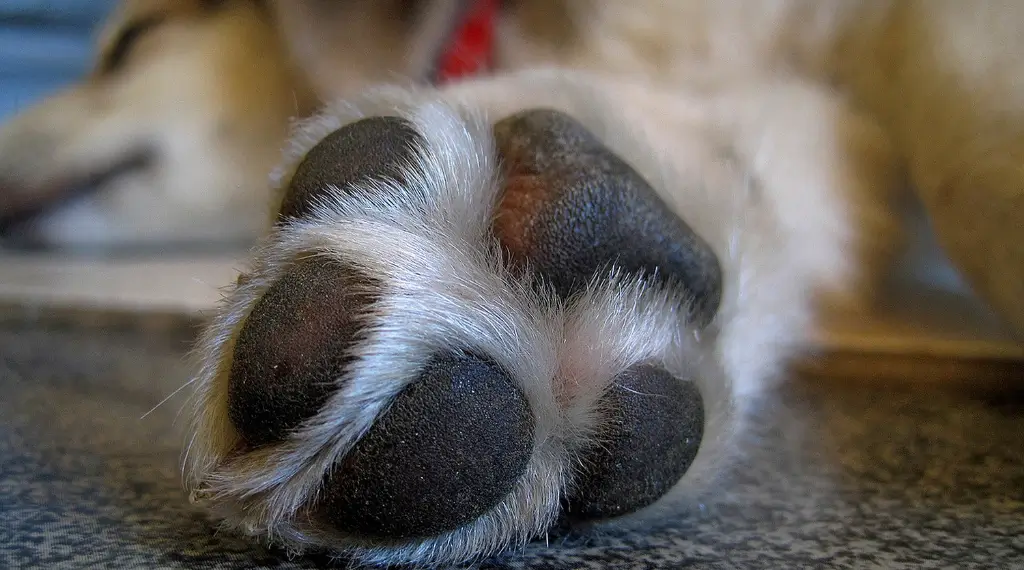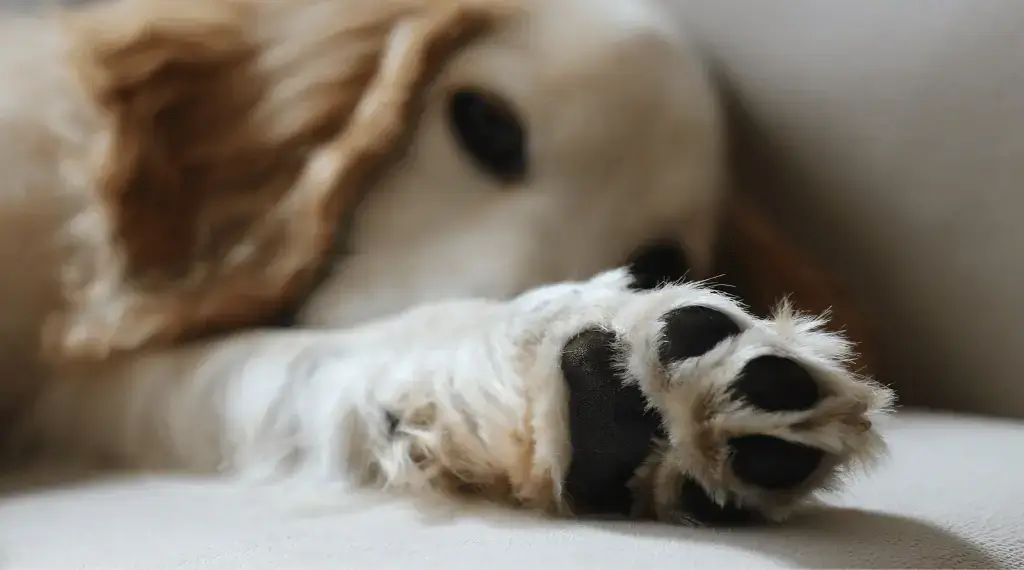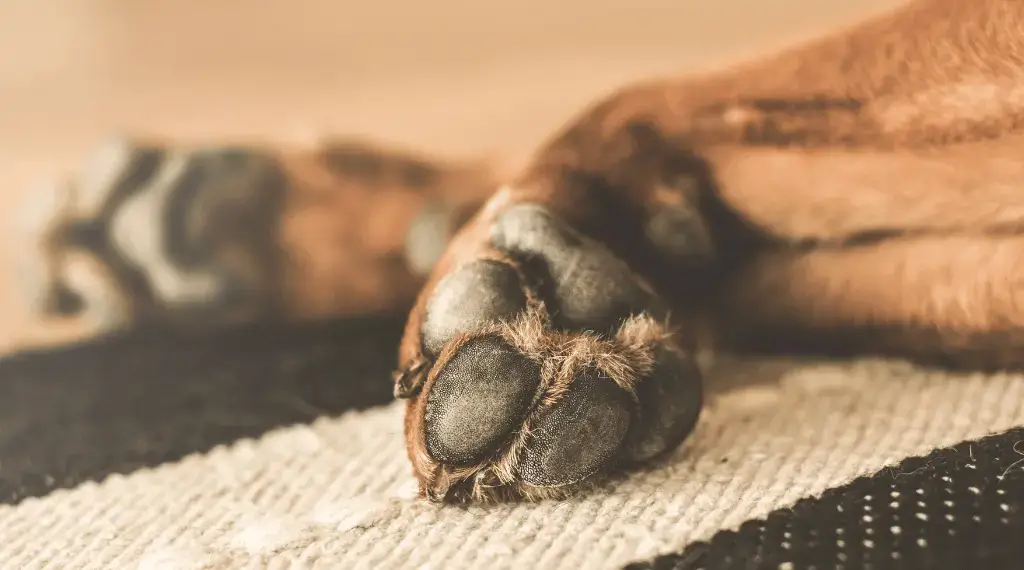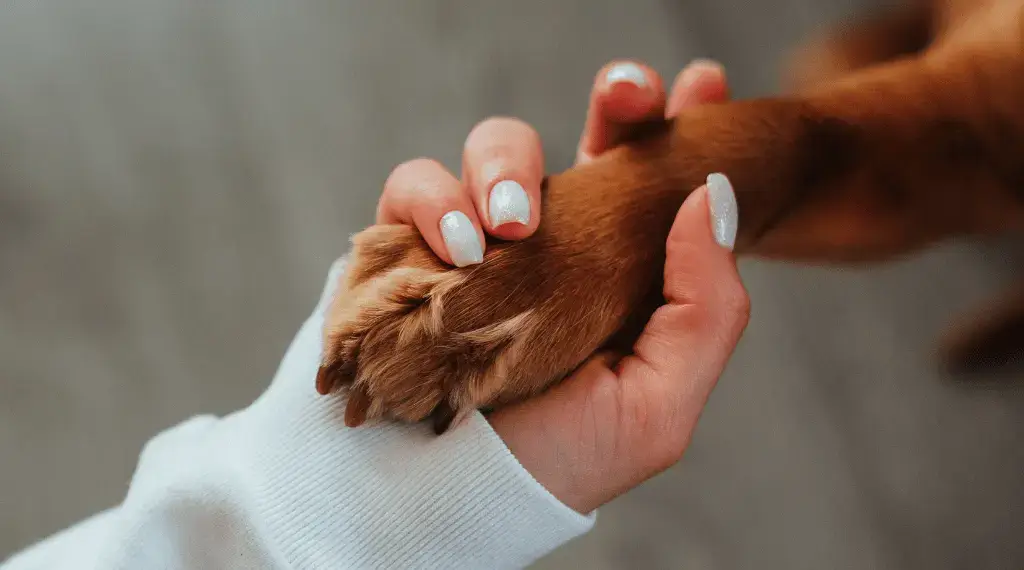Hyperkeratosis in Dog Paws: Causes and Care Tips
Hyperkeratosis in dog paws is a condition characterized by the thickening of the skin on the pads of a dog’s feet. This condition, often referred to as “hairy dog feet,” can cause discomfort and affect a dog’s mobility. Understanding hyperkeratosis is crucial for ensuring the well-being of our canine companions.
- What is hyperkeratosis ?
- Causes and symptoms of hyperkeratosis in dogs
- The importance of caring for your dog's paw pads
- Tips for preventing hyperkeratosis in dog paws
- How to properly clean and moisturize your dog's paw pads
- Natural remedies for treating hyperkeratosis in dogs paws
- Products and tools for maintaining healthy paw pads
- Common mistakes to avoid when caring for your dog's paw pads
- When to seek veterinary care for hyperkeratosis
- Conclusion: The key to happy and healthy paw pads for your beloved pet
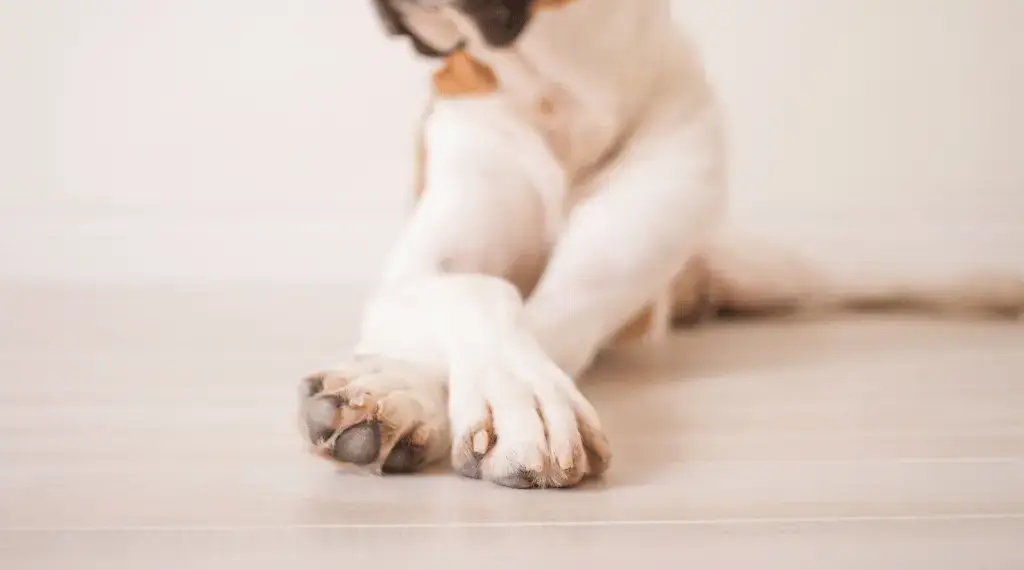
What is hyperkeratosis ?
Hyperkeratosis is a thickening and hardening of the outer layer of the skin, commonly found on the paw pads of dogs. This condition can be caused by a variety of factors, such as genetics, environmental factors, or health issues. The excessive production of keratin, a protein responsible for the strength and protection of the skin, leads to the formation of hard, calloused areas on the paw pads. This can result in dry, cracked, and rough paw pads, leading to discomfort and pain for your furry companion.
Causes and symptoms of hyperkeratosis in dogs
Hyperkeratosis in dogs can be either genetic or acquired. Some breeds are more prone to developing this condition, such as Labradors, Retrievers, and Bulldogs. Genetics play a significant role, and if your dog has a family history of hyperkeratosis, they may be at a higher risk. Additionally, certain health conditions like hypothyroidism, immune system disorders, or nutritional deficiencies can contribute to the development of hyperkeratosis.
The symptoms of hyperkeratosis are easy to spot. You may notice that your dog’s paw pads appear dry, rough, and cracked. The affected areas may become discolored or have a greyish-white appearance. Your dog may also show signs of discomfort, such as limping, licking their paws excessively, or avoiding walking on hard surfaces. It’s important to pay attention to these signs and take action to provide relief to your furry friend.
The importance of caring for your dog’s paw pads
Caring for your dog’s paw pads is essential for their overall well-being. Just like our feet, a dog’s paws are their primary mode of transportation and need to be in optimal condition. Neglecting paw pad care can lead to pain, infections, and even mobility issues for your furry friend. By keeping their paw pads healthy, you can ensure that they can enjoy their daily walks, playtime, and adventures without discomfort or limitations.
Tips for preventing hyperkeratosis in dog paws
Prevention is always better than cure when it comes to hyperkeratosis. Here are some tips to help you prevent this condition from affecting your dog’s paw pads:
- Regular paw pad inspections: Make it a habit to inspect your dog’s paw pads regularly. Look for any signs of dryness, cracking, or roughness. Early detection can help you address the issue before it worsens.
- Maintain proper nutrition: A balanced diet with essential nutrients is crucial for your dog’s overall health, including their skin and paw pads. Consult with your veterinarian to ensure that your dog’s diet meets their specific needs.
- Avoid harsh chemicals: When cleaning your dog’s paws, avoid using harsh chemicals, as they can strip the natural oils and cause dryness. Opt for gentle, pet-safe cleansers or even plain water for routine cleaning.
- Provide soft surfaces: Whenever possible, encourage your dog to walk on grass, sand, or other soft surfaces. This can help reduce the friction and pressure on their paw pads, minimizing the risk of hyperkeratosis.
- Regular exercise: Regular exercise is not only crucial for your dog’s physical and mental well-being but also helps promote healthy blood circulation, which is essential for maintaining healthy paw pads.
- Keep your dog’s paws moisturized: Moisturizing your dog’s paw pads with a paw balm can help prevent dryness and cracking. Look for products specifically formulated for dogs, as human products may contain ingredients that can be harmful to them.
By implementing these preventive measures, you can significantly reduce the chances of your dog developing hyperkeratosis and keep their paw pads in top condition.

How to properly clean and moisturize your dog’s paw pads
Proper cleaning and moisturizing are vital for maintaining your dog’s paw pad health. Here are some steps to follow:
- Gently wash the paws: Start by gently washing your dog’s paws with lukewarm water. Avoid using hot water, as it can be uncomfortable for them. You can use a mild pet-safe cleanser or simply plain water. Thoroughly rinse off any residue to prevent further irritation.
- Dry their paws: After washing, pat your dog’s paws dry with a clean towel. Make sure to dry between the toes and the paw pads to prevent moisture from accumulating, which can lead to bacterial or fungal infections.
- Moisturize with a paw balm: Once the paws are dry, apply a dog-specific paw balm to moisturize and protect the paw pads. Gently massage the balm into the paw pads, focusing on any rough or cracked areas. The balm will help soften the skin and create a barrier against environmental irritants.
- Use protective footwear: If your dog spends a lot of time outdoors or in extreme weather conditions, consider using protective footwear, such as dog boots. These boots provide an additional layer of protection and can prevent excessive wear and tear on the paw pads.
Remember to make paw pad cleaning and moisturizing a regular part of your dog’s grooming routine. Consistency is key to maintaining healthy and comfortable paw pads.
Natural remedies for treating hyperkeratosis in dogs paws
If your dog already has hyperkeratosis, there are some natural remedies you can try to provide relief and promote healing:
- Coconut oil: Coconut oil has natural moisturizing properties and can help soften the paw pads. Apply a small amount of coconut oil to the affected areas and gently massage it in. Repeat this process regularly to see improvement.
- Shea butter: Shea butter is another natural moisturizer that can soothe dry and cracked paw pads. Apply a thin layer of shea butter to your dog’s paw pads and massage it in. Be sure to use a pure, unscented shea butter product.
- Aloe vera: Aloe vera gel has soothing and healing properties, making it beneficial for treating hyperkeratosis. Apply a thin layer of aloe vera gel to your dog’s paw pads and let it dry. Repeat this process a few times a day for best results.
- Vitamin E oil: Vitamin E oil can help nourish and moisturize the paw pads. Pierce a vitamin E capsule and apply the oil directly to the affected areas. Gently massage it in and allow it to absorb. Repeat this process daily until you see improvement.
Remember to consult with your veterinarian before trying any natural remedies to ensure they are safe for your dog and won’t interfere with any ongoing treatments.
Products and tools for maintaining healthy paw pads
In addition to natural remedies, there are several products and tools available that can help you maintain your dog’s paw pad health:
- Paw balms: Look for high-quality paw balms specifically formulated for dogs. These balms contain moisturizing ingredients, such as shea butter and beeswax, to nourish and protect the paw pads. Apply the balm regularly to keep the paw pads soft and supple.
- Paw pad moisturizing socks: Moisturizing socks are designed to hold paw balm in place while allowing it to absorb into the paw pads. These socks can be particularly useful for dogs who tend to lick off topical treatments.
- Nail clippers: Keeping your dog’s nails trimmed is important for their overall paw health. Overgrown nails can cause discomfort and affect their gait, leading to paw pad issues. Invest in a good pair of nail clippers and regularly trim your dog’s nails, or seek professional help if you’re unsure how to do it safely.
- Dog boots: Dog boots provide an extra layer of protection for your dog’s paw pads, especially in extreme weather conditions or rough terrains. Look for boots that are comfortable, breathable, and provide good traction.
By using these products and tools, you can effectively maintain your dog’s paw pad health and prevent or manage hyperkeratosis.
Common mistakes to avoid when caring for your dog’s paw pads
While it’s important to know what to do to care for your dog’s paw pads, it’s equally crucial to be aware of common mistakes to avoid. Here are some common pitfalls to steer clear of:
- Using human products: Human skincare products are not suitable for dogs and can contain ingredients that are toxic to them. Always use products specifically formulated for dogs to prevent any adverse reactions.
- Over-moisturizing: While moisturizing is important, overdoing it can lead to excessively soft paw pads, making them more prone to damage. Follow the recommended application guidelines for paw balms and avoid excessive use.
- Neglecting regular cleaning: Regular cleaning of your dog’s paws helps remove dirt, debris, and potential irritants. Neglecting this step can lead to the accumulation of bacteria or fungus, causing further paw pad issues.
- Skipping nail trims: Overgrown nails can affect your dog’s gait and put pressure on their paw pads. Regular nail trims are essential for maintaining proper paw pad health.
By avoiding these common mistakes, you can ensure that your dog’s paw pads receive the best care possible.
When to seek veterinary care for hyperkeratosis
While many cases of hyperkeratosis can be managed at home, there are instances when veterinary care is necessary. If you notice any of the following signs, it’s important to seek professional help:
- Severe pain or bleeding: If your dog’s paw pads are severely cracked, bleeding, or causing your dog significant pain, it’s crucial to consult with a veterinarian.
- Persistent infections: If your dog’s paw pads show signs of infection, such as redness, swelling, discharge, or a foul odor, veterinary intervention is necessary. Infections can worsen if left untreated and may require antibiotics or other medications.
- Limping or difficulty walking: If your dog is limping or having difficulty walking, it could indicate a more serious underlying issue. A veterinarian can perform a thorough examination to determine the cause and provide appropriate treatment.
- No improvement with home remedies: If you’ve tried natural remedies and home care for an extended period with no improvement in your dog’s paw pad condition, it’s time to consult with a professional. They can assess the situation and recommend further treatment options.
Always trust your instincts as a pet owner. If something feels off or your dog’s condition is not improving, it’s better to seek veterinary care sooner rather than later.
FAQs
What is hyperkeratosis in dog paws?
Hyperkeratosis in dog paws is a condition characterized by the excessive production of keratin, leading to thickened, hardened skin on the paw pads.
Can hyperkeratosis in dogs paws be cured?
There is no cure for hyperkeratosis, but it can be managed with proper treatment and care to alleviate symptoms and prevent complications.
How can I soften my dog’s paw pads?
Using topical treatments like moisturizing balms and regular paw care can help soften your dog’s paw pads and prevent cracks.
Is hyperkeratosis painful for dogs?
Yes, hyperkeratosis can be painful, especially if the thickened skin cracks and leads to secondary infections. Proper management is crucial to reduce discomfort.
What breeds are prone to hyperkeratosis?
Breeds such as Golden Retrievers, Labradors, and Irish Terriers are more prone to hyperkeratosis due to their genetic predisposition.
Conclusion: The key to happy and healthy paw pads for your beloved pet
Caring for your dog’s paw pads is an essential part of their overall health and well-being. Understanding hyperkeratosis and implementing preventive measures can help you maintain your dog’s paw pad health and prevent discomfort or pain. Regular cleaning, moisturizing with paw balms, and providing protective footwear are all crucial steps in maintaining healthy paw pads.
In the case of hyperkeratosis, natural remedies can provide relief and promote healing. Coconut oil, shea butter, aloe vera, and vitamin E oil are all effective options to try. Additionally, there are various products and tools available, such as paw balms, moisturizing socks, nail clippers, and dog boots, that can aid in maintaining healthy paw pads.
Remember to avoid common mistakes, such as using human products or neglecting regular paw pad care. If your dog’s paw pad condition worsens or does not improve with home care, seek veterinary care promptly.
By prioritizing your dog’s paw pad health, you are ensuring their comfort, mobility, and happiness. Your furry friend will thank you for providing them with happy and healthy paw pads for a lifetime of adventures.
The ABCs of Dog Paw Anatomy: A Simple Guide
The ABCs of Dog Paw Anatomy: A Simple Guide Welcome to a fascinating exploration of…
Paw Cleaners for Dogs: Top Products for Happy Paws
Paw Cleaners for Dogs: Top Products for Happy Paws As a dog owner, you know…
Why Do Dogs Paws Smell Like Fritos ? The Surprising Cause
Why Do Dogs Paws Smell Like Fritos? The Surprising Cause Have you ever cuddled up…
Dog Paw Pad Peeling: Causes and Solutions
Dog Paw Pad Peeling: Causes and Solutions What is Dog Paw Pad Peeling? Have you…
Create Lasting Memories with Dog Paw Print Kits
Create Lasting Memories with Dog Paw Print Kits Are you a dog lover looking for…
Dry Dog Paw Pads: Causes, Prevention, and Treatment
Dog Paw Pads Dry: Causes, Prevention, and Treatment Have you noticed your dog’s paw pads…




